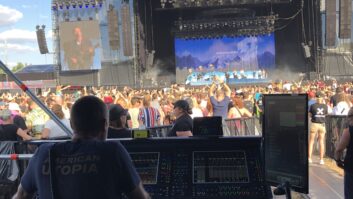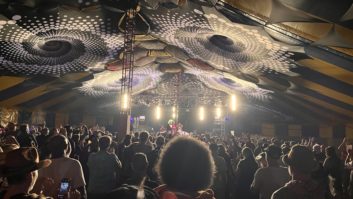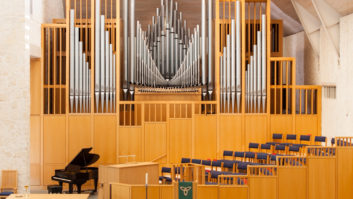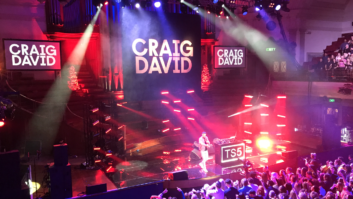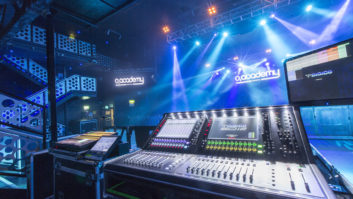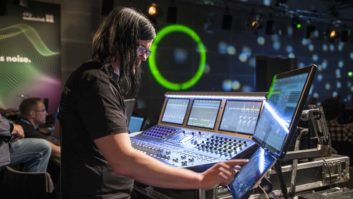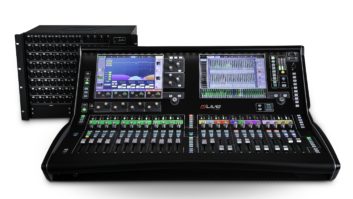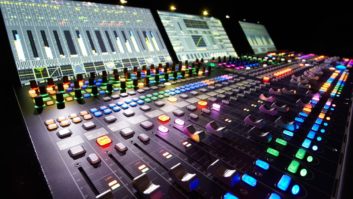The expectations of fixed installation customers for their audio mixing systems to be compact, versatile and cost-efficient were among the primary trends highlighted during IE’s last extended survey of this market in November 2007. All of these requirements still hold true but, for the short term at least, are now arguably overshadowed by the frankly remarkable growth and diversity of the digital console segment.
While no one is suggesting that the demand for analogue systems is about to disappear completely, the digital desks’ flexibility of configuration, near-elimination of outboard gear requirements and potential for networking are convincing more and more installation customers to jump into the world of zeroes and ones.
“Everyone is going digital now,” observes Xavier Pion, sales and marketing director at Innovason. “Very few installations will invest in an analogue desk today. That is a very big change and it implies that the needs and expectations of fixed installs is to see their system evolve and improve with new software versions, features, modules and network solutions.”
As will be abundantly clear to anyone who has attended an AV trade show recently, manufacturers have been engaged in almost frenetic levels of activity, with many bringing new products to market, or refining existing ones, during the past 12 months.
New product frenzy
At the higher end of the market, DiGiCo has followed up its acclaimed SD7 digital console with (logically enough) the SD8, 298 of which had been ordered as of late October. Midas has introduced its second networked digital audio system, the PRO6, and continued to record strong sales for its first, the XL8, with 100 systems out in the market at last count. Digidesign has sought to enhance the appeal of its VENUE live performance range to installation customers by introducing the Mix Rack system, which combines all I/O, computer control and processing power in a single compact package.
Manufacturers catering to a wider range of price points have also been engaged in new developments. Yamaha has introduced a stagebox, the SB168-ES, to complement its LS9-16 and -32 consoles, and continued to record good business for its PM1D, PM5D and, in particular, M7CL systems.
Soundcraft – the manufacturer perceived by some to be its closest competitor – has also been active, with orders remaining strong for its Vi6 and Vi4 consoles; there is also high demand for the recently launched Si3. Soundcraft sister company Studer remains a popular install choice, especially its Vista 5 and 8 desks.
Several other players have also strengthened their positions during the last year. A resurgent Innovason has launched its Eclipse desk to widespread acclaim, while Lawo – the company that helped to secure its future – has publicised a number of high-profile installations involving the mc2 series consoles.
Elsewhere, RSS by Roland has continued to promote the M-400 V-Mixing System, which is based around an integrated package of digital snake and mixing console. Allen & Heath, meanwhile, has added extra functionality to the iLive digital live sound system through new software updates. The Cornwall-based manufacturer is poised to launch new digital I/O expanders for its iDR digital installation series.
In short, despite the often phenomenal R&D expenses attendant to the creation of modern mixing systems, an increasing number of manufacturers have been willing to engage with this market segment and offer their own particular take on the digital revolution.
Consequently, installers and their clients now face an unprecedented level of choice when it comes to specifying an audio mixing system – be it for a major theatrical venue, a cutting-edge club or a house of worship. Whatever the required price point, functionality or level of operator expertise, the chances are that there is now a system out there to fit the bill. Moreover, increments in quality are now manifesting themselves more strongly in the lower- and medium-price products.
“The whole market has changed. High-quality digital mixing consoles are now accessible at lower price-points, and customers have a much greater understanding of them,” says Simeon Ludwell, technical sales engineer at UK pro-audio supplier/installer Autograph Sales. The company generally favours three console brands – DiGiCo, Yamaha and Allen & Heath (“all have different strengths and features, allowing us to cover all markets that we encounter”).
Also providing encouragement for console developers is the fact that, at least for now, demand from the installation sector appears to be equal to the profligacy of product. While not entirely discounting the possibility that the current economic downturn – more of which anon – could destabilise the market, Midas Consoles’ managing director, John Oakley, speaks for many when he observes the headlong rush for quality now characterising the installation business.
“More and more fixed install situations are starting to understand the need for really high-quality sound and better sound systems, and they are investing more in it,” he observes. “As a result, there is real growth in that area of the market.”
Demanding development
With fixed installation accounting for an increasing share of many manufacturers’ order books, it stands to reason that the sector’s requirements are exerting an influence on new product development. Arguably topping the wishlist is ease of use, a concern that comes into particularly sharp focus in the houses of worship (HoW) market, where operators may often be partially skilled at best.
“A HoW can have a very sophisticated digital console and a highly complex sound system, but you can find that it will be operated by people who are not necessarily professionally trained sound engineers,” confirms Andy Brown, product manager – pro live, Soundcraft & Studer. “The ease-of-use aspect, then, is a key driver. Our Vistonics touchscreen user interface is designed to be incredibly simple to learn and use, and reduces the likelihood of critical settings being changed by mistake.”
“The HoW market has a great deal of influence over some aspects of functionality,” says Karl Christmas, deputy general manager, Yamaha Commercial Audio. “Simplicity of use is one major point, but you also need to provide the ability to lock out or limit certain functionality of a console. You will often have different levels of user operating the console in any given week, and you want to be able to prevent access to certain settings, for example output EQs and delays.”
Automation requirements are another important driver, particularly for theatres. Cadac analogue consoles remain a popular choice in this market, and indeed the manufacturer – despite experiencing well-publicised difficulties this year – has recently reported encouraging orders for its first full digital desk, the S-Digital.
“When we launched the S-Digital earlier this year, we in essence brought to the theatre and live markets a choice between two Cadac console designs that are entirely comparable in terms of audio quality and operational functionality,” says Cadac’s managing director, Bob Thomas.
“The choice is then simply whether a production wishes to remain with analogue or move to the digital domain… The reaction to the S-Digital has been totally positive and it is being seen as meeting the expectation that it would maintain the sound and operation of the much-loved J-Type with the addition of the advantages that derive from a digital design.”
The Luton-based company is, however, by no means the only manufacturer seeking to satisfy the often exacting requirements of this market.
“We have been working on software upgrades for digital consoles that tailor them more specifically to the theatre market by providing a lot more functionality on the snapshot/automation side,” says Brown, noting that the Studer Vista 8 is particularly well developed in this regard. “It’s a level of functionality that is rarely used in most touring or music applications, and it does create challenges as regards the prioritisation of developing these extra features.”
“Automation requirements are getting more complicated and application specific,” agrees Oakley, “and we have included many new advanced features in the PRO6, such as complex event management.”
Rising expectations
The issue of automation leads naturally into broader areas of functionality and configurability. Covering all bases with regard to interfacing and connectivity is one thing, and indeed most manufacturers accommodate a wide variety of options.
But with an increasing number of installations encompassing multiple rooms – for example, a typical theatre fit-out might include the performance space itself, rehearsal rooms and a recording facility – the onus is on manufacturers to facilitate easy transportation of sound around a building. Coupled with this is the growing recognition of the opportunities afforded by genuine networked solutions as installers begin to pull away from straightforward point-to-point operation.
The move towards greater implementation of networking solutions is, says Oakley, “partly driven by customers and partly by our side as we think these things are very useful. When they are available, people will use them and want more of it, and that is precisely what we are seeing at the moment.”
Transportation and networking technologies will be the subject of a separate feature in the February 2009 issue of Installation Europe. For now, it is enough to note that while EtherSound, CobraNet and MADI, in particular, have all achieved a creditable level of adoption, there remain a multiplicity of options. As a result, customers working to implement a network will often be led inexorably to the specification of a one-brand/group solution.
“Everyone tends to operate on their own self-contained island, which might be Midas/Klark Teknik, Harman, Digidesign and so on,” says Oakley. “At the moment, we’re not really being asked to interwork between different mixing console environments, although I think that will come as time moves on and we start getting into the re-equipping or partial re-equipping of installs.”
For now, Oakley and the Midas/KT organisation are focusing firmly on the SuperMAC AES50/HyperMAC technology, purchased from developer Sony Oxford in 2007, which is now available on a royalty-free basis to promote its general use. An AES50 to other format converter is also promised soon from Klark Teknik.
Suffice to say that, in the absence of overwhelmingly dominant transportation or networking technologies, manufacturers are obliged to keep track of installation customers’ changing requirements and ensure that as many options are incorporated as possible.
Pointing out that Allen & Heath’s iLive digital live sound system has its roots in the earlier iDR digital installation series, company product manager Leon Phillips observes that “feedback from installers and venues demonstrates that the market is constantly looking to improve the flexibility of digital audio distribution and connection. This is done by reducing the need for cabling and enabling easy interface with industry standard protocols, such as EtherSound and AES/EBU. This means that much of our R&D time is spent developing the software that will increase hardware flexibility and functionality.”
There is also increasing demand for built-in recording capabilities, as illustrated by the inclusion of an on-board recorder in Innovason’s latest console. “The Eclipse has an onboard 64-track recording system, fully integrated and interfaced through the touch screen of the console,” says Pion.
“In medium-sized venues, when they need to record in multi-track, they don’t need a recording van or any external device. They usually have no space for external devices or have to install them remotely, which means cables, connectors, and so on. They are happy to have a console that mixes 104 inputs into 48 busses and has a multi-track recorder in such a small footprint.”
Digidesign’s European sales manager of live sound, Mike Case, also picks up on the escalating demand for integrated recording. “With regard to the installation market in general, the key feature of the Digidesign VENUE system over the competition is still the seamless Pro Tools integration as venues look for additional revenue streams and in-house recording facilities,” he observes.
Finally, for DiGiCo, the drive towards rack and I/O sharing is of fundamental importance. “The ability to perform all the splits in one of our racks and run everything in the digital domain makes large cost savings on the installation,” says managing director James Gordon, who notes that the D5 and D1 ranges are among DiGiCo’s strongest sellers in fixed install. “It also means that more of the budget can be spent on the product rather than the infrastructure.”
Rewarding applications
In terms of specific applications, it is the houses of worship market that prompts the greatest excitement among mixing console manufacturers and suppliers, many of whom depict a segment experiencing phenomenal growth – and not just in the US.
“The houses of worship market has always been strong for Digidesign in the US, but it is beginning to grow across Europe,” says Case.
“The worship market is growing rapidly in Asia and parts of Europe,” says Christmas. “The number of churches and the sophistication of the operations is quite remarkable. A lot of them are offering commercial services – hosting conferences, concerts, etc – meaning that they are often, in essence, multipurpose venues centred around their faith.”
More traditional install types – theatres, concert halls and clubs – are also remaining robust sources of new orders.
“There is a good level of demand from theatres and classical concert halls. The future is digital,” declares Sebastian Mueller-Eckhard, sound engineer at audio supplier/installer B+B Veranstaltungstechnik Dortmund, which regularly provides Soundcraft and Yamaha desks to installation customers in the Dortmund area.
“Lawo’s products are being used in a wide range of applications from broadcast to production to live and theatre applications,” says Lawo’s PR manager, Wolfgang Huber. “For example, the mc2 series can be found in studio control rooms small and large, OB vans, theatres, concert halls and congress centres.”
“The feedback we are getting is that the V-Mixing system is doing extraordinarily well, whether it goes into theatres – largely because of its functionality, flexibility and footprint – or into education,” says RSS by Roland’s general manager, Peter Heath. “It’s gone to several colleges or universities where music or music technology are part of the curricula. It’s a very good tool on which to learn digital mixing.”
In addition, despite the current economic downturn and fears of a prolonged recession, it seems that customers across the board are still exhibiting a willingness to invest – provided they can be assured of quality, reliability and support.
“People will still need to get on with business,” explains Christmas, “but they will invest more cautiously. They will also look for stability in investment – in other words, a product they know will work and continue to be reliable – and a high level of support.”
“The money is definitely there,” claims Ludwell. “We have several very big projects coming up, so the future looks exciting.”
It is impossible not to wonder whether, in the long term, this increasingly competitive area of the market will be able to support so many manufacturers. Right now, however, the drive towards greater audio quality for fixed installations – and the readiness of customers to invest accordingly – makes this one of the most exciting and rewarding of all AV technology markets.
